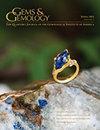天然黄色和橙色宝石钻石:氮因子
IF 1.6
3区 地球科学
Q2 MINERALOGY
引用次数: 4
摘要
2020年夏季宝石与宝石在花式钻石中,饱和蓝色、绿色和红色的钻石是最稀有的,通常也是最受重视的。然而,在过去的十年里,这些颜色的纯色调钻石在GIA检查的所有钻石中所占比例不到1%的十分之一,这使得它们在市场上几乎无法获得。在最近几期的《宝石与宝石学》中,我们记录了最稀有的花式钻石的宝石学和光谱特性,从粉色到红色、蓝色、绿色,再到更不寻常的白色和黑色。这篇文章将讨论最常见的彩色钻石,即黄色的钻石,同时也研究它们更罕见的橙色表亲(图1)。这是本系列中最后一个花哨的颜色组,文章末尾对所有彩色钻石组进行了简要总结。黄色和橙色钻石的颜色主要是由于在地球深处生长过程中,钻石晶格中含有氮杂质。氮是天然金刚石中最常见的杂质,这是由于氮原子和碳原子的原子半径非常相似(分别为155和170皮米范德华半径),以及生长环境中氮的相对丰度-本文章由计算机程序翻译,如有差异,请以英文原文为准。
Naturally Colored Yellow and Orange Gem Diamonds: The Nitrogen Factor
GEMS & GEMOLOGY SUMMER 2020 Among fancy-color diamonds, those with saturated blue, green, and red colors are the rarest and generally the most highly valued. Over the last decade, however, diamonds with pure hues in these colors have made up less than one-tenth of one percent of all diamonds examined at GIA, making them virtually unattainable in the marketplace. In recent issues of Gems & Gemology, we have documented the gemological and spectroscopic properties of the rarest of fancy-color diamonds ranging from pink-to-red, blue, and green to the more unusual white and black. This article will address the most common colored diamonds, those with yellow hues, while also examining their much rarer orange cousins (figure 1). This is the last of the fancy color groups in this series, and a brief summary of all the colored diamond groups is provided at the end of the article. Yellow and orange diamonds owe their color primarily to nitrogen impurities that are incorporated in the diamond lattice during growth deep in the earth. Nitrogen is the most common impurity in natural diamond due to the very similar atomic radii of nitrogen and carbon atoms (155 and 170 picometer Van der Waals radii, respectively) as well as the relative abundance of nitrogen in the growth environ-
求助全文
通过发布文献求助,成功后即可免费获取论文全文。
去求助
来源期刊

Gems & Gemology
地学-矿物学
CiteScore
2.90
自引率
19.20%
发文量
10
期刊介绍:
G&G publishes original articles on gem materials and research in gemology and related fields. Manuscript topics include, but are not limited to:
Laboratory or field research;
Comprehensive reviews of important topics in the field;
Synthetics, imitations, and treatments;
Trade issues;
Recent discoveries or developments in gemology and related fields (e.g., new instruments or identification techniques, gem minerals for the collector, and lapidary techniques);
Descriptions of notable gem materials and localities;
Jewelry manufacturing arts, historical jewelry, and museum exhibits.
 求助内容:
求助内容: 应助结果提醒方式:
应助结果提醒方式:


